Bear & Breakfast is a light-hearted management simulator about a sociable bear who becomes the proprietor of several bed and breakfasts spread across a lush pine rainforest. Silver Valley was once a popular destination for humans, but they stopped visiting after a vague and dark disaster. A shady company called Pawn Voyage heralds their return, urging anyone passing by one of their shark-shaped intercoms to renovate nearby abandoned buildings into bed and breakfasts. Thanks to this impersonal business plan, and in a sunny parody of the anonymous contractor-driven gig app economy, a bear named Hank becomes a wealthy and successful innkeeper with none of his human guests suspecting his true identity. I play as Hank as he explores Silver Valley to open paths between all its corners, completes quests for its eclectic human and animal residents, gathers resources to build and buy all the things he needs to satisfy his guests, and transforms the lonely Valley into a well-managed bed and breakfast empire.
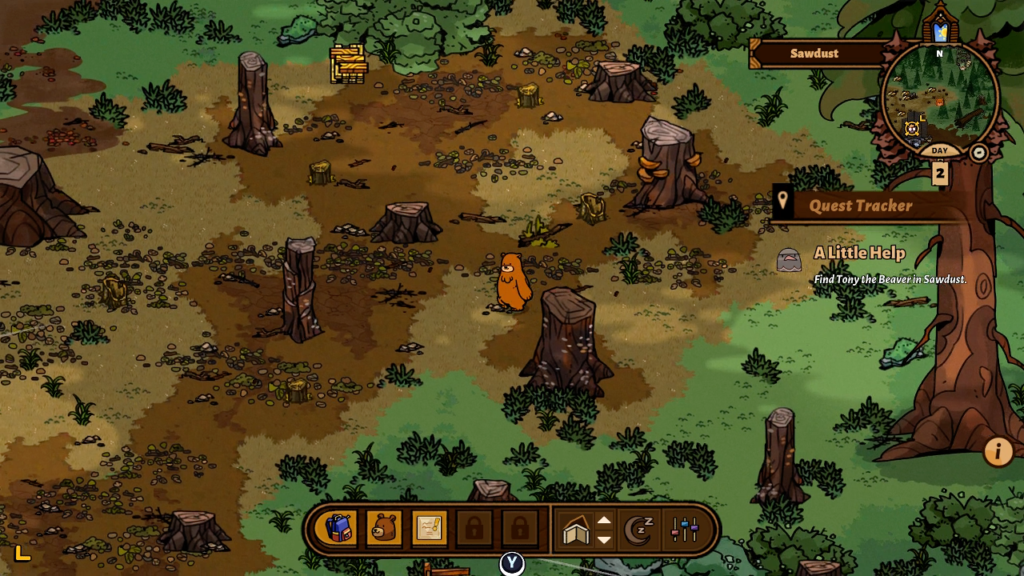
The highest praise I can bestow upon Bear & Breakfast is its presentation. Silver Valley is captured by thick, bold lines outlining every bright, colorful detail. This lends the art a quality akin to a child’s storybook which complements the fun, almost naive story. Character animations also evoke this feeling; Hank memorably lopes through the forest, big arms swinging with a dopey smile on his face. Even though visiting humans run in fear from Hank—at least until I outfit him in unlockable human clothes—there is nothing threatening about him. This is a friendly game about a friendly bear who just wants to make his guests comfortable and happy, and the graphics lend themselves to this feeling throughout.
This friendly feeling makes the moments when Bear & Breakfast becomes surprisingly dark stand out all the more. The contrast is jarring. It opens with Hank having a nightmare where he wanders an endless sea of black clouds while shining, lidded eyes glare at him from above. I wonder just how this leads into the premise, and there’s never a good answer. The nightmarish imagery and supernatural events become more and more prevalent as I near the sudden and abrupt ending, and not once do I feel like they belong in a videogame about a bear who semi-clandestinely manages a bed and breakfast chain.
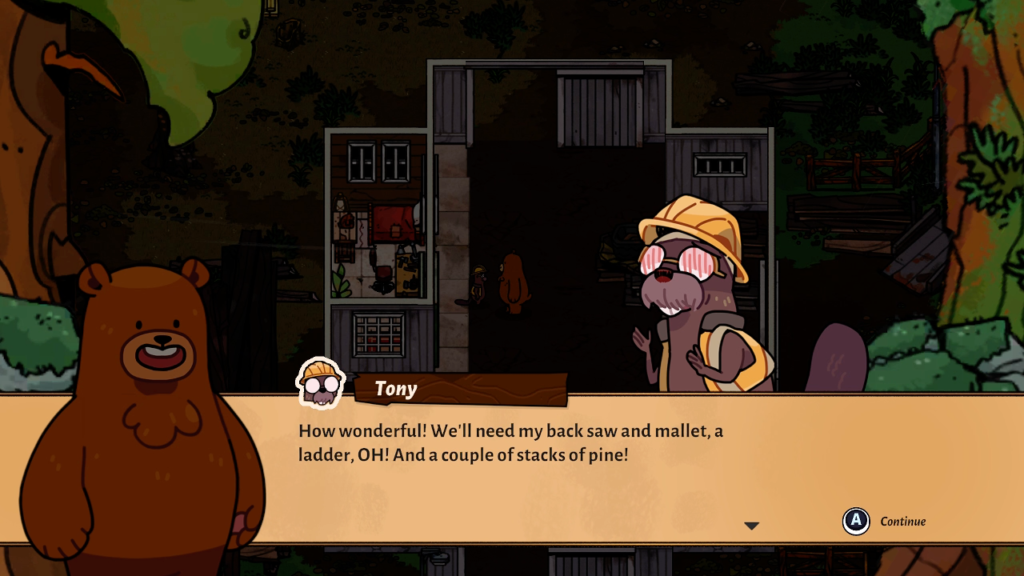
Bear & Breakfast’s design is divided into two distinct halves. The more obvious half is the management simulation which is built into its premise. Less obvious is the large amount of adventuring and questing. There are almost a dozen different areas to explore around Silver Valley, from the forest heart where Hank lives with his mother, to an arid highway, a freezing mountain slope, and a rocky beach. By wandering these locales and completing quests for its diverse residents, Hank gains management of five different bed and breakfasts and the resources to upgrade and maintain them.
This adventuring is what allows Bear & Breakfast to have its discordant plot. Characters like Oliver, the human bus driver who has begun ferrying others of his kind to the Valley, or Sabine, a park ranger and one of the few humans that understands the animals’ speech, give basic fetch quests to Hank. There is nothing groundbreaking about them. They ask Hank to retrieve a certain item that is lying on the ground somewhere in the world, or ask him to travel somewhere and speak with another character. These two objectives typify the entire adventure, and completing them unlocks new areas and progresses the simplistic plot forward.
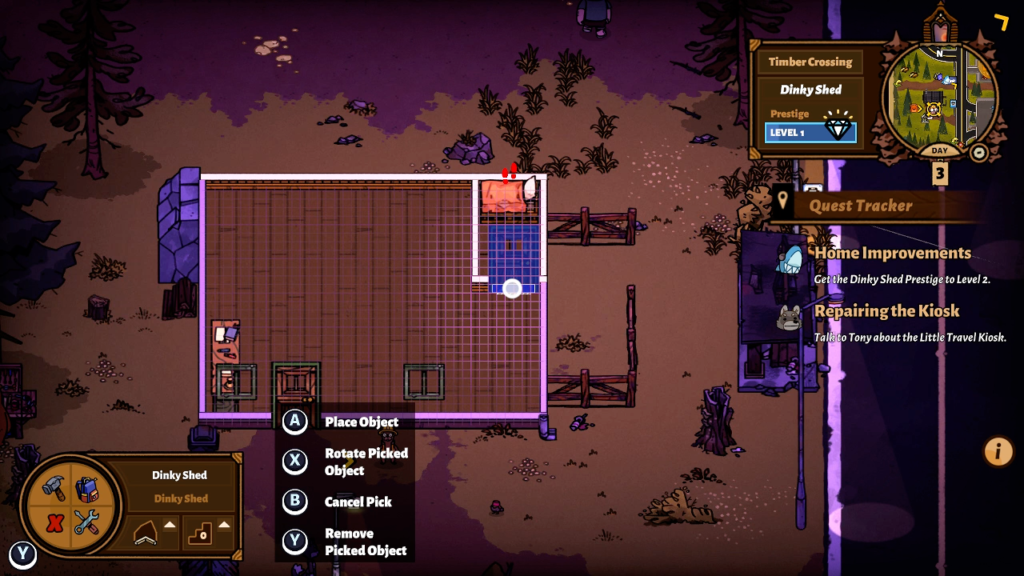
Each of the five properties Hank renovates into bed and breakfasts have unique features. The first is a humble shack. Since it only requires Hank to build simple bedrooms, it offers a good introduction to building rooms. I can build as many rooms using as many right-angles that the property will fit, but I cannot alter a property’s dimensions. Each has a minimum furniture requirement—bedrooms require a bed—and anything additional I place in the room increases its comfort and attractiveness values.
I can either build furniture out of the wood, stone, and electronics Hank scavenges across Silver Valley, or buy decorations from an enterprising raccoon named Took who operates out of a dumpster. Took does not value the money that Hank earns from his guests, but rather the trash they leave behind in their rooms and around Silver Valley. As I adventure with Hank, I am constantly filling his pockets with thousands of pieces of litter to trade for fancier furniture from Took.
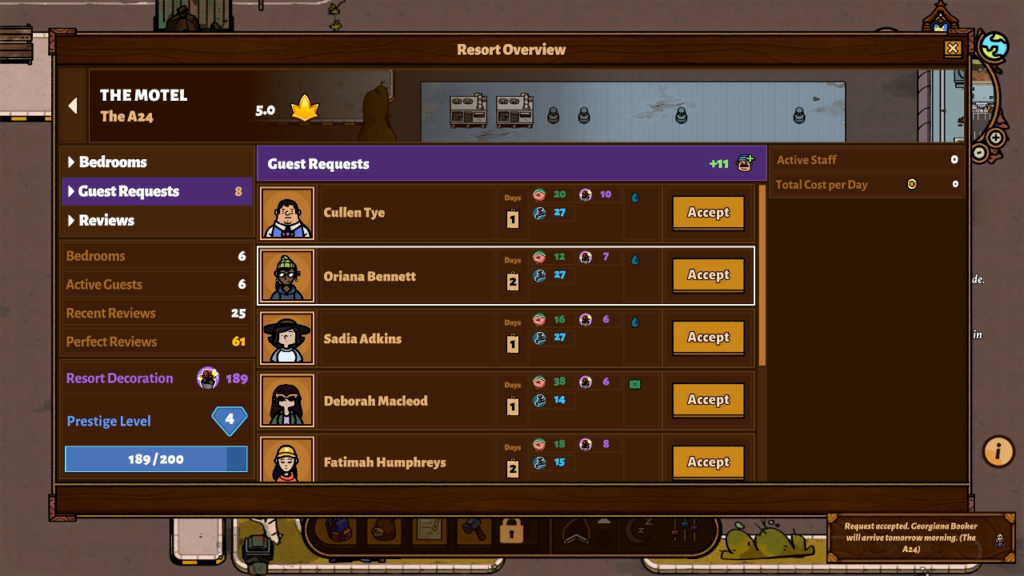
More discerning guests expect higher comfort and attractiveness values from their rooms, but are willing to pay more as a result. This creates an appealing loop. Nicer rooms attract more and wealthier guests, who give Hank more money and trash to build nicer rooms, which attracts more and wealthier guests.
Properties grow in complexity past the first bed and breakfast. The second adds guests who expect in-door bathrooms and want to relax at an on-site bar. The third grows to a two-story building with an adjoining campsite, and guests here expect catered meals to be provided by Hank using a kitchen and dining room. The final property is large and complex enough to be its own management videogame, combining the elements of all the previous properties across several buildings that sprawl across the endgame area.
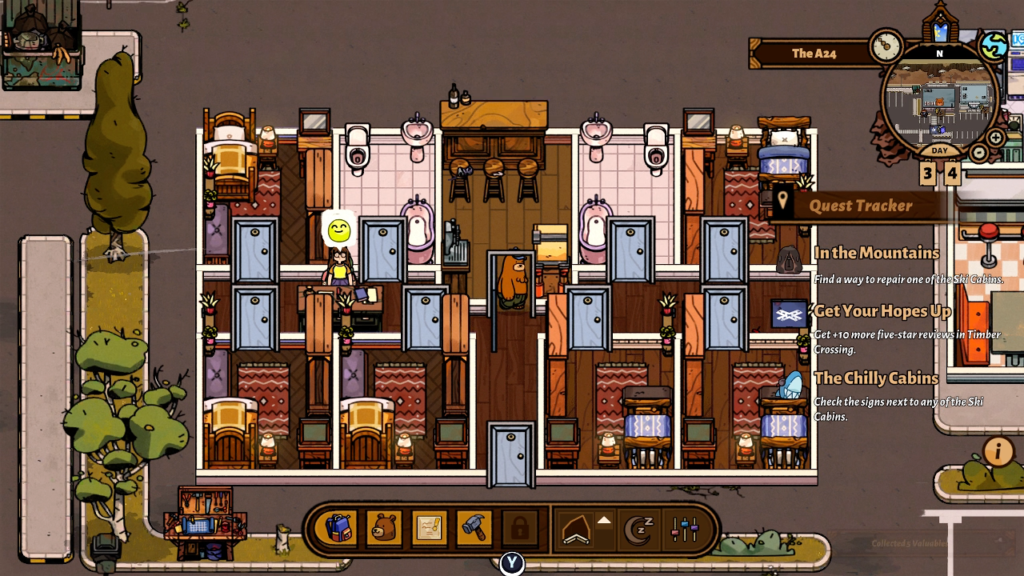
Establishing a property is only the first step. Once I have fitted a new bed and breakfast out with a minimum number of bedrooms and supporting amenities, I’m free to progress Hank towards the next one. If I choose to continue visiting his current properties, optional goals are introduced which offer new rewards, including several tools that streamline Hank’s management jobs. Again, these goals begin simple—the first property only wants fancier rooms and satisfied guests—but each new property sets more challenging goals which require thoughtful room placement within limited space. If I’m particularly enjoying Bear & Breakfast’s management half, these extended goals are where most of my effort will go.
Where adventuring and management interact is where Bear & Breakfast feels repetitive. Adventuring exists to give Hank something to do while waiting for new guests to check in. Multiple times, the plot comes to a standstill while mandating Hank reach new management milestones, such as hosting a certain number of guests or stockpiling a large number of coins. The only thing to do while waiting to reach these milestones is wander around filling Hank’s pockets with new crafting materials. I find that even once his pockets and his stash are overflowing with every kind of material, there is still a lot of time left before reaching those milestones.
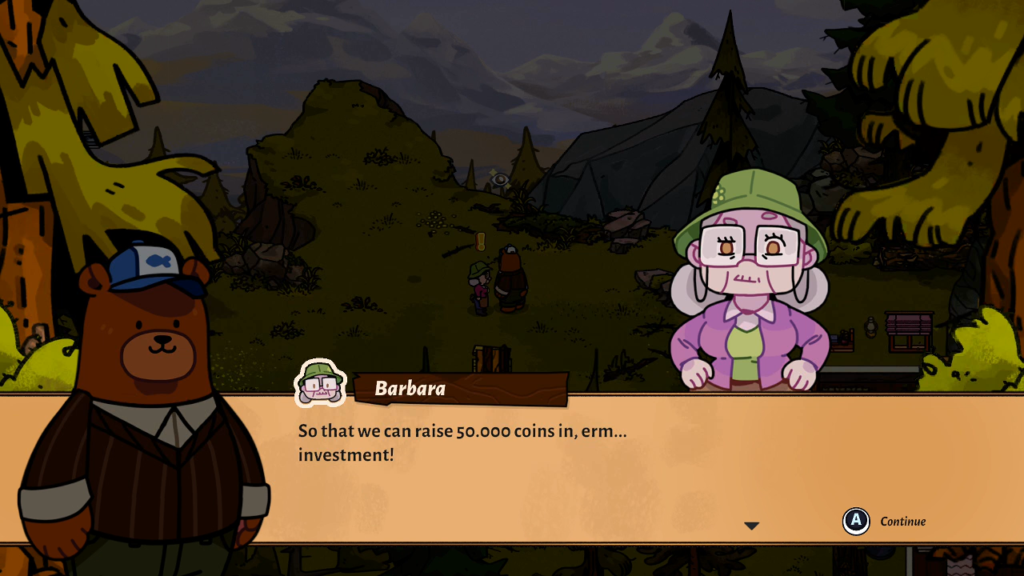
A lamentable plurality of my time in Bear & Breakfast is spent with nothing to do besides watch numbers creep towards an arbitrary goal. This includes the postgame, when I have finished every quest in Silver Valley but still have many ambitious and challenging management goals left to fully develop every property. Some management videogames overwhelm me with more to do than I can possibly accomplish in a single in-game day, forcing me to prioritize. Bear & Breakfast instead has tall, narrow peaks of productivity then long, interminable troughs where I guide Hank aimlessly around the Valley, waiting for days to pass by, for guests to check in and out, and numbers to go up.
Despite my misgivings about how much idle time it imposes upon me to progress, I do praise Bear & Breakfast for its art style, its simple adventure design, and its audaciously silly management simulator premise. This is why I am so disappointed to also write that it sabotages itself at almost every turn with one of the most infuriating user interfaces and control schemes I have ever encountered.
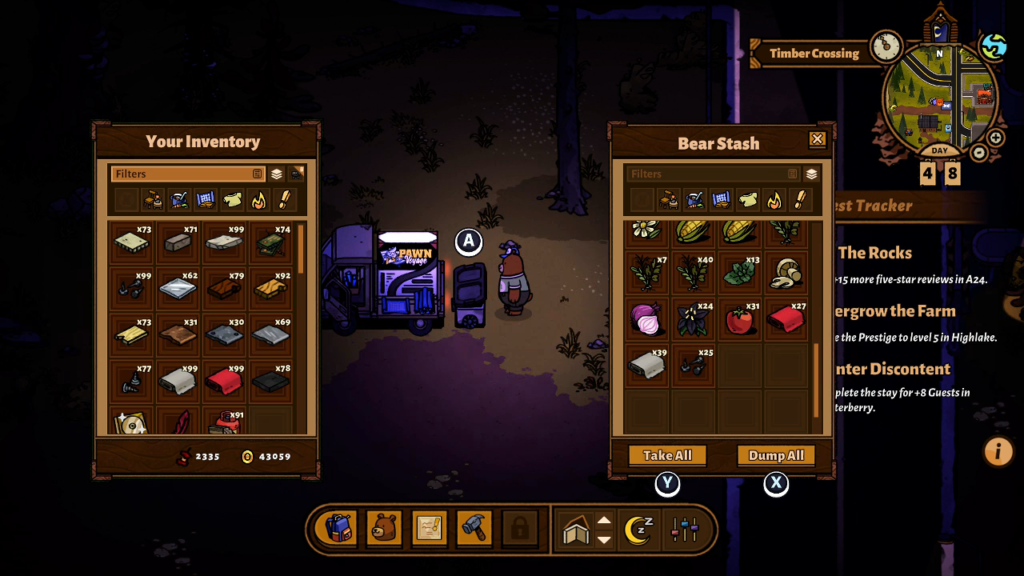
The interface’s main failing is it requires an inordinate amount of mouse-clicking to accomplish basic tasks. This is tedious, but accomplishable when playing with an actual mouse. It’s how these controls are translated to a gamepad that they fall flat. I urge all to avoid Bear & Breakfast’s Switch port, or any other forthcoming console ports, as though they are being offered a lit firecracker. It is best played on a PC and nowhere else.
I could ramble on for a thousand words about the many ways Bear & Breakfast’s interface fails console players, but to keep things brief, I will list them all quickly and with minimum elaboration, letting their quantity and density speak for themselves.
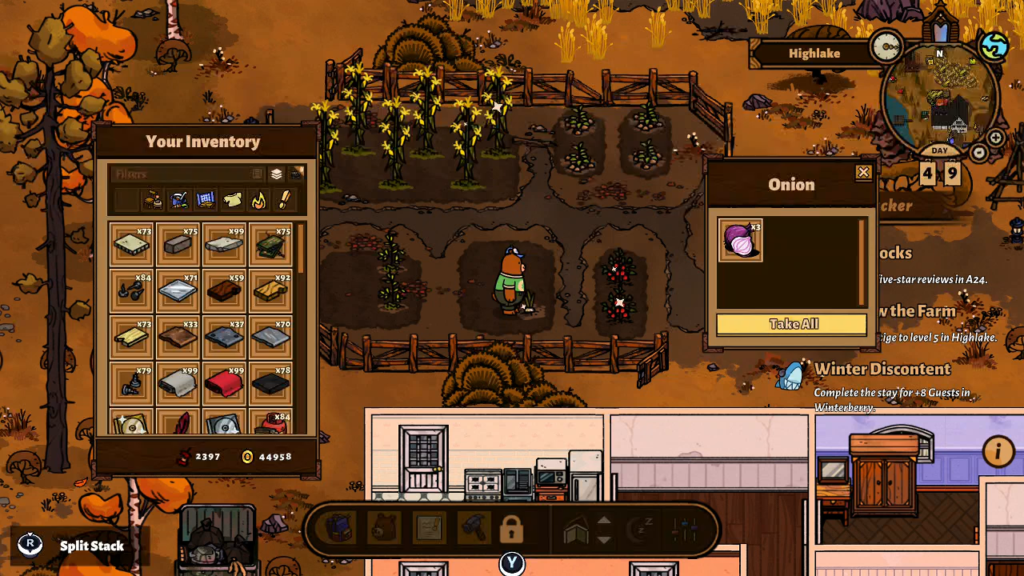
The Y button is used to switch between different “levels” of the interface, so it is often unclear where the cursor is currently located. The Y button also withdraws everything from Hank’s stash. Multiple times while trying to switch between interface levels, I end up taking everything out of the stash instead. There is no quick-move option; each item in Hank’s inventory must be picked up and dropped individually into a container. This becomes a compounding problem: The more items Hank carries, the more of a chore it is to move them between inventory and container. Items dropped into containers do not automatically consolidate into single stacks.
The difficulties with the interface carry on into the property management. Hank’s stash and the crafting table are not linked; if I want to build anything, I have to use materials already in Hank’s pockets to do it. This invites more awkward shuffling of items between container and inventory. Once in the build mode, I cannot construct furniture needed to complete a room while assembling the room. It must be pre-assembled in a completely different menu.
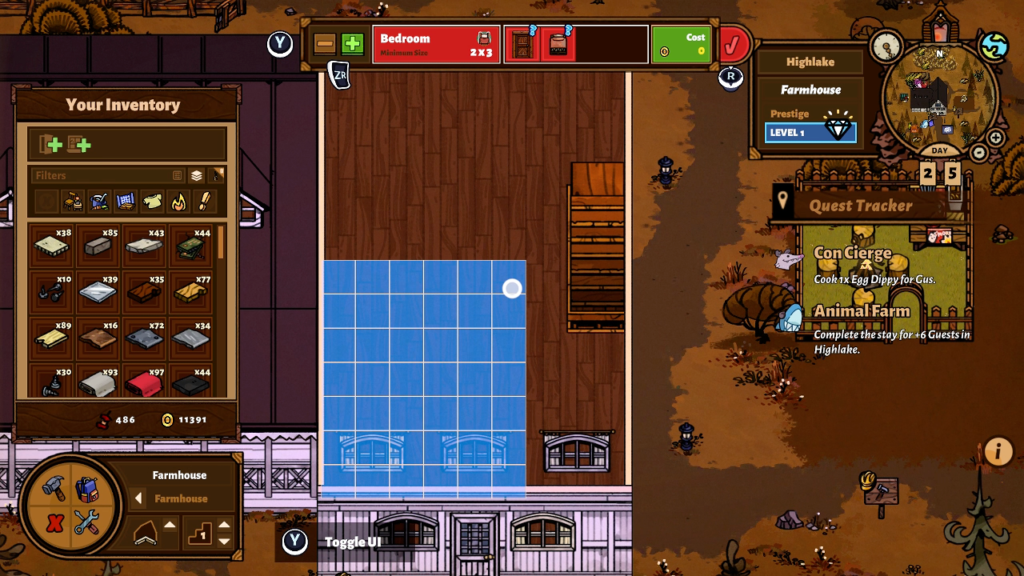
It is impossible to move a room once it has been assembled. If I need to adjust a building’s interior layout, my only choice is to delete everything inside it and start over. Here I am most tempted to give Bear & Breakfast some latitude as such an option is doubtless difficult to program and taxing to hardware, but I constantly felt its absence as mandatory disassembling and reassembling rooms only subjected me to further interaction with the interface.
Nowhere does Bear & Breakfast suffer from its interface more than the cooking activity introduced at the third property. It’s a calamitous collision of every interface problem. First, kitchens must be continuously upgraded with new, increasingly large appliances which require constant adjustments to room size. They also require mountains of food which can be scavenged all across Silver Valley and stored in containers at each property or in Hank’s stash.
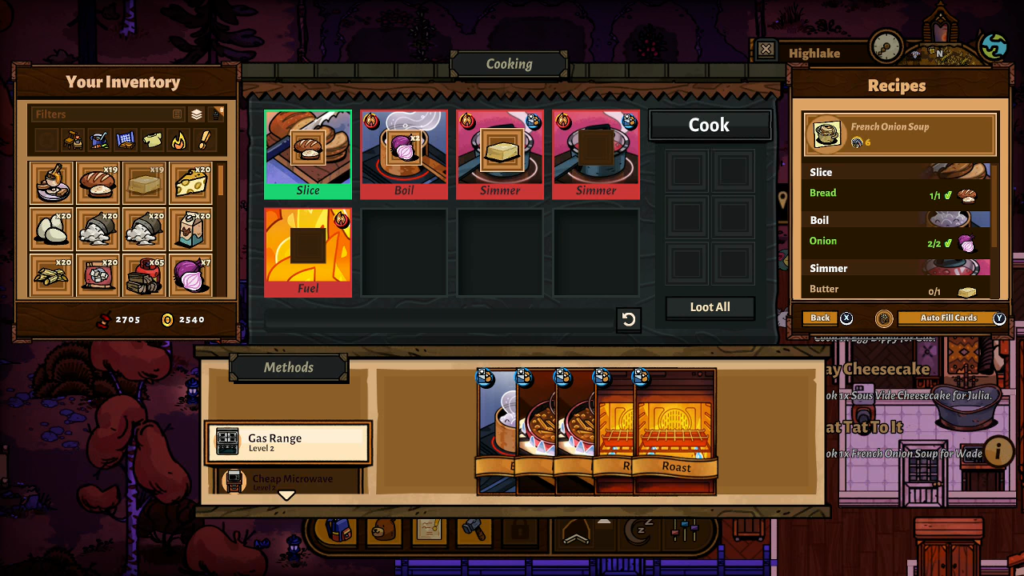
Once my appliances are in place and Hank’s inventory filled with supplies, I may begin cooking. I first have to select a recipe from a menu, which is in one part of the interface. This recipe adds “cards” representing each cooking step to the central cooking window in another part of the interface. I then have to select, one at a time, each piece of food for each step from Hank’s inventory, a third part of the interface, and drop it on the appropriate card. From there I can click “Cook” and after a few seconds, a few prepared meals will appear which must be manually placed in Hank’s inventory, walked to the Dining Room, and moved into yet another container.
I complain that Bear & Breakfast gives me little to do while waiting for management goals to be reached. The truth is I could easily fill that time grappling with the laborious cooking interface, but it’s such a torturous experience that wandering around picking up more wood Hank doesn’t need is preferable. Only an option to hire a professional chef, available almost at the plot’s end, makes maintaining the later bed and breakfasts semi-tolerable. Until this option is available I avoid operating them past the minimum requirements. The cooking experience is that repellant.
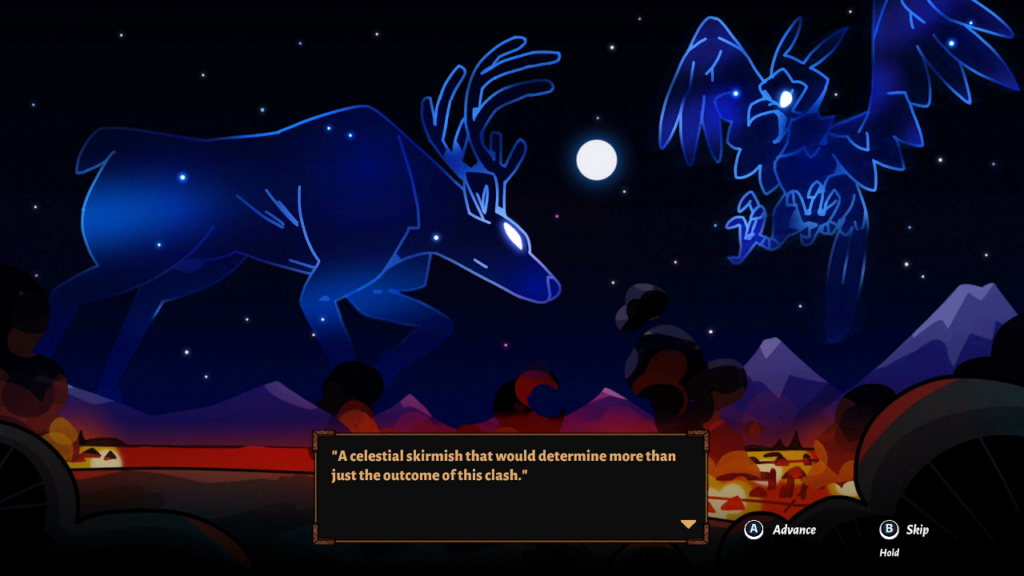
Bear & Breakfast is a wonderful, whimsical idea sabotaged by execution. The plot goes to discordantly dark and tragic depths that don’t complement its offbeat, slightly satirical premise. This would be easy to discount as just another quirk of its strange base, but actually organizing Hank’s inventory and managing his bed and breakfasts grows into a daunting chore. There’s joy to be found here when controlling Hank with a keyboard and mouse, buried beneath a ponderous mountain of mouse clicks, but console versions should be avoided. With a gamepad, Bear & Breakfast is more frustration than joy.